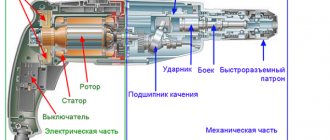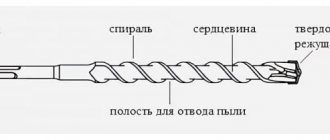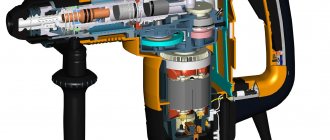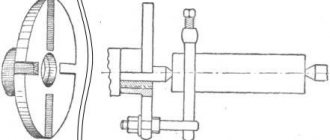When choosing a chuck for a hammer drill, the buyer must understand the design of such a clamping device. This will allow you to immediately resolve questions about which tool in the kit can be used with a hammer drill and what types of processing can be performed using such equipment. In addition, knowledge of the structure of the hammer drill chuck allows you not only to independently replace the clamping device, but also to carry out its simple repairs, if the need arises.
The hammer chuck designs have been specially designed to withstand the harsh operating conditions of the tool.
How do chucks for hammer drills work?
To effectively use different hammer drill bits, you need to ensure that they are securely attached. A special cartridge is used for this. Its first models began to be developed back in the 30s of the last century, when hammer drills appeared on the market, the mass production of which was mastered by the world famous company Bosch.
Such a manual device as a hammer drill was almost immediately appreciated by consumers, since it can be used to combine drilling with pulse chiselling, which significantly increases the efficiency of the processing performed. The main drawback of the first models of rotary hammers was precisely due to the fact that the weakest link in their design was the cartridge, which quickly became unusable under the influence of shock loads.
As a result of long-term development, manufacturers of hammer drills and chucks have come to the following conclusion: the simpler the design of the clamping device, the more reliable it is in operation.
Externally, the hammer chuck is a completely closed clamping device
As a result, three main types of cartridges for rotary hammers were created, which in turn are divided into subtypes.
Gear-crown (key)
There are chucks in which the working attachment is fixed using a special key that activates cams that reliably clamp the shank of the tool being used. The most significant advantage of this type of chucks is that they provide reliable fastening of the tool used in conjunction with the hammer drill. Meanwhile, to replace the working tool in such a chuck for a hammer drill, you will need to spend significantly more time than when using other types of clamping devices.
The main types of chucks for rotary hammers
are Quick-release chucks (KLC).
The working attachment of a rotary hammer can be fixed on it using a quick-release chuck (KLC), which is activated only by the force created by the operator’s hands. Depending on the design, cartridges of this type can be single- or double-clutch, the operating principles of which also differ.
Single-socket chucks are easier to use, but they can only be used in conjunction with drills that have the ability to automatically lock the working shaft. To activate such a cartridge, the effort of one hand is sufficient. To use a double clutch clamp, you need to hold the rear clutch with one hand and rotate the front clutch with the other.
The best SDS-Max rotary hammers with an impact force of 12-20 J
These are units for the most difficult tasks. With their help, it is easy to knock down walls, punch large holes (expand window and door openings), remove layers of concrete from floors, etc. But the increased impact force affects the impact and ease of working with the tool. Here are the best hammer drills with the SDS-Max cartridge and an impact force of 12-20 J.
Makita HR 4511 C
The first place in the ranking of the best is given to the Japanese Makita hammer drill. The product is notable for its power of 1350 W, impact force of 13 J, electronic speed control from 130 to 280 per minute and impact frequency of 1250-2750. The hammer drill weighs 8.5 kg. A long cable of 5 m allows you to do without carrying it in most cases. To make holes in concrete, you can use drills with a cross-section of up to 45 mm and crowns of 125 mm.
Watch the product video
+ Pros of Makita HR 4511 C
- Adjustable impact force from 2.7 to 13 J, for materials of different densities.
- Network cable 5 m.
- The product is manufactured at production facilities in the UK.
- Good anti-vibration performance.
- Cable fault indicator and power button.
- The rubberized body will last a long time, despite repeated impacts and falls.
— Cons of Makita HR 4511 C
- There is no reverse.
- Your hands get tired quickly.
- The screws in the case are gradually unscrewing - you need to tighten them.
- The mode slider is difficult to switch.
- Periodically shuts down due to overheating.
Conclusion. The main difference between this hammer drill and other participants in the rating is its compactness. The case length is 458 mm, although most competitors have this figure from 600 mm. This SDS-Max unit is suitable for working in cramped conditions (installation of plumbing in bathrooms, drilling in the attic, basement or inside a panel room). Here you can also choose not only the number of strikes, but also the level of force. This will help you carefully make a hole in both brittle and very hard materials.
Bosch GBH 8-45 D
Powerful hammer drill with 1500 W motor. The maximum diameter of the equipment is allowed: drill - 80 mm, crown - 125 mm. The impact force is 12.5 J, and the number of shocks is adjustable from 1380 to 2750 per minute. The cartridge rotates at a speed of 305 rpm. The kit comes with a plastic case and a tube of lubricant. For clean drilling there is a soft start. The housing behind the cartridge is heavily perforated for faster heat dissipation. When the drill bits, the fuse is triggered and the chuck does not rotate with the engine.
Watch the product video
+ Pros Bosch GBH 8-45 D
- Double main handle that can be held with both hands.
- There is a locking start button for constant chiselling, so as not to keep the trigger pressed.
- Recessed mode switch.
- A long additional handle with a 360-degree change in position relative to the barrel.
- A stable platform for placing the tool on a plane.
- Easily drilled into concrete foundation screed.
— Cons of Bosch GBH 8-45 D
- You have to rest your elbow on your leg or stomach, otherwise it’s difficult to keep your weight up.
- Strong kickback in the hands during chiseling mode.
- Grease flies out of the SDS-Max cartridge.
- Weight 8.2 kg is heavy to operate and transport.
- Power cord 3 m.
- Without vibration protection.
Conclusion. The product is worth a closer look for those who often work with equipment 500-600 mm in length. Typically, towards the end of drilling, the speed of the equipment may drop due to increased resistance. This model is equipped with a Constant Electronic system, which will not allow the speed to drop even with increasing load.
Makita HR5212C
Makita produces this hammer drill with the SDS-Max chuck as the flagship among the representatives of the professional line. The power of the device is 1510 W and it is capable of striking up to 1100-2250 times per minute with a force of 20 J. The rotation of the equipment occurs at a speed of 150-310 revolutions. The housing is equipped with anti-vibration inserts. It is allowed to work with drills with a diameter of 52 mm and hollow bits of 160 mm. All controls are located within reach of the left hand. An indicator light indicates the need to replace the brushes.
Watch the product video
+ Pros of Makita HR5212C
- Almost completely rubberized body.
- Comfortable grip and non-slip handle.
- Long trigger for all fingers of one hand.
- The mode switch does not catch on clothes.
- Clear operation of operator protection when biting equipment.
- The auger, 11 m long and 62 mm in diameter, easily passes through clay (suitable for drilling wells).
— Cons of Makita HR5212C
- The wind from the cooling system blows straight into your face.
- Loud engine operation.
- Weight of 12 kg requires frequent breaks from work.
- No reverse.
- Large dimensions 599x140x287 mm.
- It will be inconvenient for lefties.
Conclusion. This hammer drill is a leader in performance and impact force. Its rating is 20 J. This makes it easy to destroy wall materials and ceilings, remove top layers or drill stone. User reviews like the constant chiseling button, which relieves the finger during long-term use.
What is SDS
SDS (SDS) is an acronym made up of the first letters of the words Steck, Dreh, Sitzt, which translated from German mean “insert, turn, secured.” It is on this simple, but at the same time ingenious principle that the SDS cartridge, developed by Bosch engineers in the 80s of the last century, works. Today, 90% of all manufactured rotary hammers are equipped with these easy-to-use devices, which ensure high reliability of fixing the working tool.
SDS chucks are often called quick-release chucks, but they should not be confused with devices in which clamping is achieved by rotating the couplings. Unlike traditional quick-release chucks, the SDS clamp does not need to be rotated to secure the tool; you just need to hold it with your hand.
To understand the design of a hammer drill chuck of this type, as well as the principle of its operation, just look at the tool shank, which is designed to be fixed in such a device, or the SDS adapter. This shank has 4 grooves, two of which are open at the end of the shank, and the other two are closed. Open grooves act as guides; they ensure the correct position of the tool when it enters the chuck. The closed grooves, in turn, ensure the fixation of the shank in the hammer drill chuck.
Scheme of the impact mechanism of a rotary hammer
In the inner part of the SDS cartridge there are special balls that perform two functions simultaneously. At the moment when the tool is just inserted into the hammer drill, the balls along which the guide grooves move ensure its correct position. After the tool is inserted all the way, such balls fix it, for which it is necessary to turn it a little until the balls enter the closed grooves of the shank. To make using the SDS chuck even easier, it is recommended that the tool shank not only be thoroughly cleaned after each use, but also lubricated.
It should be borne in mind that due to the design features of SDS chucks, the tool that is fixed in them is subject to slight radial runout at idle, which does not in any way affect the accuracy of the processing performed. Meanwhile, the presence of a small play between the shank and the inner surface of the chuck protects the latter from the impact to which drills are exposed during the operation of the hammer drill.
To protect against contamination, all hammer drill chucks are equipped with rubber boots.
In what case should you purchase a hammer drill with an SDS-Max chuck?
If light and medium hammer drills are suitable for drilling, installing anchors, dowels, and chiselling a wall to make a hole for communications, then the SDS-Max models can perform the function of a real jackhammer.
With their help you can easily:
- remove a thick layer of reinforced concrete;
- destroy a wall partition made of brickwork or concrete blocks;
- remove asphalt from the road;
- split heavy rock.
They can be used for simpler tasks (drilling a hole for a cable or pipe in the wall, making a ventilation outlet, cutting a niche for an outlet, etc.), but due to the increased power of the tool, such work will be completed much faster. Therefore, SDS Max hammer drills are purchased not only for heavy dismantling work, but also for installing electrical or plumbing in large volumes. Then they pay off due to productivity and help to deliver the project faster.
Rotary hammers with SDS Max cartridges weigh from 5 kg, which is important to consider when choosing, because if you have to work a lot on the ceiling, you will need more frequent breaks. Security requirements here are much higher. The lightweight SDS+ can weigh 3-4kg, making it much easier to hold at height. The operation of this powerful tool requires a highly skilled operator and is therefore only suitable for professional use.
Understanding the purpose of a powerful tool, let’s consider the rating of SDS-Max rotary hammers, which will help you see already tested models with positive reviews. The advantages and disadvantages of the product will simplify your choice and allow you to spend your money wisely.
Types and scope of application of SDS cartridges
Depending on the diameter of the shank with which the tool or adapter is equipped for fixing it on the hammer drill, SDS chucks are divided into five main types: regular SDS chucks, models of the SDS-top, SDS-quick categories, as well as SDS-plus and SDS-chucks. max. The most popular are the SDS-plus category chucks, which are designed to hold tools with a shank diameter of 10 mm. The shank of the tool, adapted for fixing devices of the SDS-plus category, enters them to a depth of 40 mm. In this case, the diameter of the working part of the tool, which is fixed in SDS-plus chucks, can be in the range of 4–26 mm.
The maximum tool length that can be clamped in SDS-plus chucks is 1 meter, and its most common working diameters are in the range of 6–12 mm. Devices designed to hold SDS-plus shanks and corresponding adapters for rotary hammers in them are used to equip light and medium category equipment, the weight of which, excluding the weight of the tool, ranges from 3 to 5 kg. It is precisely these hammer drills, which are designed for impact loads of up to 5 J, that are most popular among home craftsmen and small repair teams.
Common types of SDS shanks
SDS-max chucks, with a bore diameter of 18 mm, are used to equip heavy professional rotary hammers, whose weight starts from 5 kg. Such hammer drills, which can be used in conjunction with tools with a working diameter of up to 6 mm, are able to create an impact load of up to 30 J. To ensure accurate and reliable fixation of the tool in such serious equipment, an additional guide groove is provided on shanks of the SDS-max category .
SDS-top and SDS-quick chucks are intermediate options for equipping rotary hammers and are used much less frequently than the models described above. Meanwhile, the design of SDS-quick devices, which were developed by Bosch engineers in 2008, is worth a closer look. The tool is inserted into the SDS-quick series chucks not using grooves, but through protrusions on the shank. The design features of SDS-quick chucks allow them to hold tools with a hexagonal shank and a quarter-inch size.
The SDS-quick system is used in Bosch UNEO cordless hammer drills
Blog about construction and renovation
To choose the right hammer drill, you should consider that they come in three types: light, medium and heavy. Each of them differs in size, impact force, as well as the types of shanks used on the cartridge, which are SDS plus and SDS max. In order to understand the main differences between the most popular SDS type shanks, you first need to consider their design features and application. SDS plus They are used in most cases in light and medium-class rotary hammers, and are widely used in everyday life. Designed for rotary hammers weighing 2-4 kg. Drills holes up to 26 mm. Features of SDS plus 1) 4 grooves: 2 open, for inserting drills, 2 closed, for fixing them; 2) diameter of shanks 10 mm; 3) fits into a 40 mm cartridge; 4) recommended drill length: min 110 mm, max 1000 mm; 5) contact area of the wedges is 75 mm2. SDS max Used by professionals for more complex work with a hammer drill weighing from 5 kg. Heavy-duty tools are equipped with this type of fastening. Designed mainly for impact work, without drilling. Drilling with a diameter of more than 20 mm is carried out. SDS max rotary hammers have two modes: drilling with impact and impact without drilling. Features of SDS max 1) has 5 grooves: 3 open, guide the equipment, 2 closed, fix it; 2) shank diameter 18 mm; 3) insertion into the cartridge by 90 mm; 4) the contact area of the wedges is 389 mm2. Larger shank diameter increases tool reliability. This is one of the reasons why rotary hammers with SDS max chuck can handle more complex tasks. Which hammer drill company should you choose? There are about ten foreign and domestic brands on the hammer drill market, offering good quality products in the middle price segment. Foreign manufacturers include BOSCH, Metabo, Makita, DeWalt, and Russian manufacturers include Vikhr and Zubr. First of all, you should pay attention to the impact force of the model. It will determine what materials you can work with, how long the process itself will last and how comfortable it will be. A tool with low (up to 2 J) or medium (4 to 10 J) impact force is suitable for home use. Professionals should take a closer look at hammer drills with a stronger impact of 17 J and a power of 1500 W. Another important parameter for any master is the ergonomics and weight of the device. Naturally, the heavier the instrument, the more powerful it is. Therefore, professional hammer drills can weigh from 7 to 12 kg. You won’t be able to hold such a tool in your hands for a long time, which may affect the pace of work. But you can’t do without such a hammer drill, for example, if you make socket boxes or make a groove in a concrete wall. Option two: choose an easier hammer drill. The optimal weight for home is 3-5 kg. Last but not least, the factor is the type of food. It is logical that there are wired and wireless devices. The first ones are perfect for home repairs, since the outlet is most often at hand. Cordless hammer drills are useful in a de-energized facility where there is no electrical wiring yet. Conclusion: When studying different models, we pay attention to the price-quality characteristics, technical parameters and user reviews about the tool. Here are the brands of rotary hammers for work, including middle-class models that are popular among buyers. They are more affordable and suitable for home repairs or outdoor activities. • BOSCH • Makita • DeWalt The price of a hammer drill varies from 6,000 to 50,000 rubles. If you buy one that is too cheap, it may not handle the power or have a short service life. Too expensive, on the contrary, often contains inflated parameters that are not needed, but you will have to overpay for them. The best option in this situation would be to contact a company that provides rental construction tools. Renting power tools designed for various tasks is of interest to professional builders, no less than to home craftsmen. In case of failure of standard equipment, seasonal increase in volumes, or solving complex problems, rental tools save you from image and financial losses. Hammers, drills, crowns, adapters, peaks you can select and order via the link
How to disassemble and assemble a cartridge yourself
To perform maintenance and repair of a hammer drill chuck with your own hands, it is important to properly remove and disassemble this device. Knowing how to disassemble a hammer drill chuck (or how to disassemble a drill chuck), you will be able to independently inspect, clean and even make minor repairs to its internal elements, which will allow you to always maintain your tool in good technical condition. The simple design of SDS cartridges allows them to be removed and disassembled even by people who are not comfortable with technology.
So, disassembling the classic SDS hammer drill chuck is performed in the following sequence.
Step one:
Move the plastic part away from the cartridge and remove the rubber seal.
Removing the hammer drill chuck.
Photo 1 Step two
Using a screwdriver, remove the fixing ring, and then the fixing washer.
Removing the hammer drill chuck.
Photo 2 Step Three
When the locking washer is removed, you can see a second ring underneath it, which also needs to be removed using a screwdriver.
Removing the hammer drill chuck.
Photo 3 Step Four
After all the rings and washers have been removed, you can begin to disassemble the SDS mechanism, which consists of a washer, a ball and a spring. First of all, it is necessary to remove the ball from such a mechanism, then the washer and only then the spring.
Removing the hammer drill chuck. Photo 4
All parts of the cartridge mechanism, if you perform maintenance, must be cleaned of dirt and dust, lubricated, and then reassembled in the reverse order.
To get to know in even more detail the question of how to remove a chuck from a rotary hammer or drill, how to properly disassemble it, perform maintenance or minor repairs, you can study not only theoretical information, but also watch the corresponding video.
About attachments for rotary hammers
Theoretically, a tool with a shank for SDS-plus chucks and even a tool with an even smaller seat diameter can be installed on a hammer drill chuck of the SDS-max category. To solve this problem, a special attachment (adapter) is used, which today can be purchased on almost any construction market. Meanwhile, it is strictly not recommended to use such adapters for a rotary hammer, since using a tool of a smaller diameter on heavy-duty rotary hammers will quickly render it unusable.
As a rule, tools for rotary hammers are sold immediately in packages and cannot be restored after failure. However, it should not be confused with conventional drills, which differ from it in the shape of the sharpening and the structure of the spiral.











